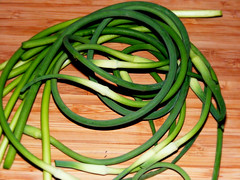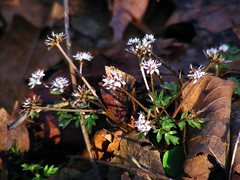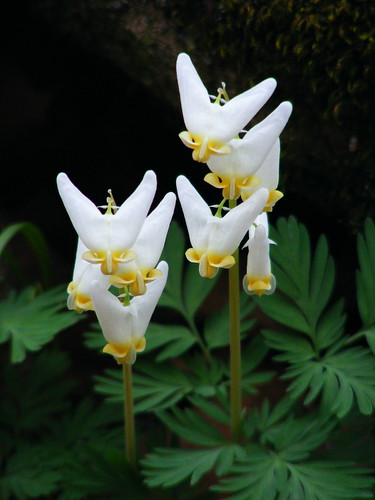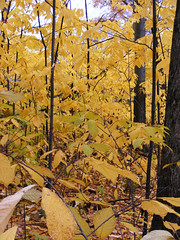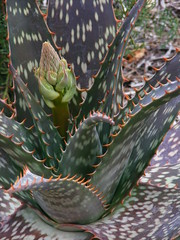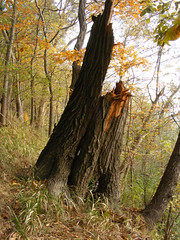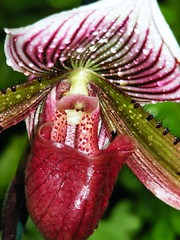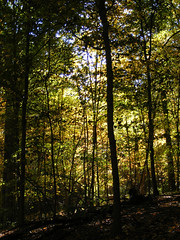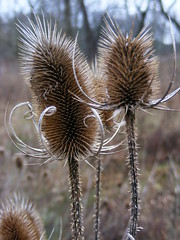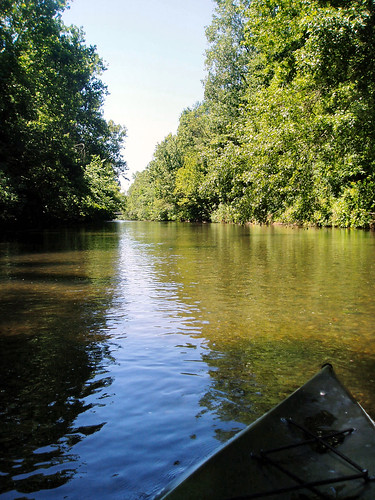- Run a 15K mini-marathon
- Run a half marathon (I don't know if this will happen, but I'm going to train for it)
- Get my weight down to xxx (you don't need to know the exact number now, do you?)
- Complete three ArcGIS classes
- Develop the perfect recipe for whole wheat bread in my bread maker
- Finish three knitting projects and six sewing projects
- Update this blog on a regular basis
Wednesday, December 31, 2008
My New Year's Resolutions
Monday, October 06, 2008
Petrichor
Besides, I like rain. As much as I like to get outside and run or hike or kayak, there's also something wonderful about being inside with the rain beating down and curling up with a good book.
Rain please. Soon. Now.
Sunday, October 05, 2008
My First 5K
 So, at the tender age of 48, I've completed my first ever 5K race. I ran in the Reggae Run and despite the challenging course, I not only finished, but I still had a smile on my face near the end. It really was a lot of fun and I can see why people get hooked on running races.
So, at the tender age of 48, I've completed my first ever 5K race. I ran in the Reggae Run and despite the challenging course, I not only finished, but I still had a smile on my face near the end. It really was a lot of fun and I can see why people get hooked on running races.I finished in 41 minutes. Obviously I'm not going to be breaking any records but I'm tickled that I did that well and that I never broke out of a run even on the hills. I just ran slower - much slower. Walkers could pass me by, but that's fine and dandy. Now I've set my sights on the 10K Turkey Trot on Thanksgiving morning - training begins tomorrow.
Saturday, September 27, 2008
World Rivers Day
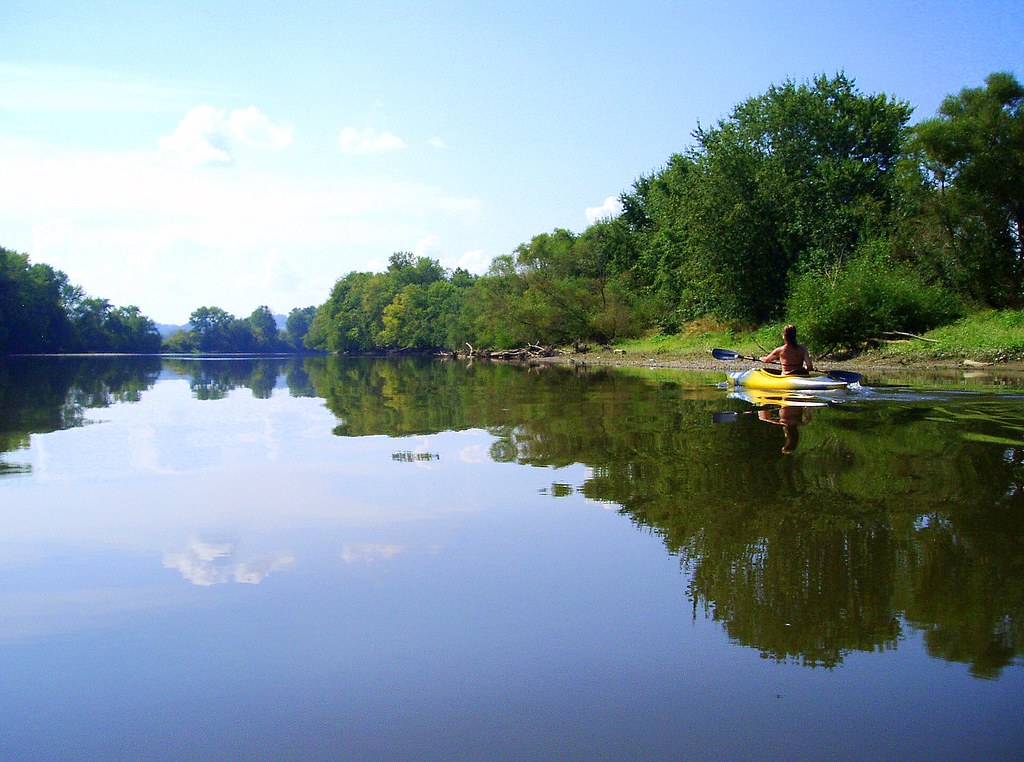 September 28th marks World Rivers Day, established in 2005 to promote a greater awareness of the role rivers play in our lives. Unfortunately I won't be out on a river tomorrow, since I've already made plans to attend the Ohio Renaissance Festival with friends, but I did paddle the mighty Muskingum River for sixteen miles last weekend with a good friend (pictured). The village of Dresden, Ohio held its first annual Melon Festival last Saturday along with the first annual Paddlefest.
September 28th marks World Rivers Day, established in 2005 to promote a greater awareness of the role rivers play in our lives. Unfortunately I won't be out on a river tomorrow, since I've already made plans to attend the Ohio Renaissance Festival with friends, but I did paddle the mighty Muskingum River for sixteen miles last weekend with a good friend (pictured). The village of Dresden, Ohio held its first annual Melon Festival last Saturday along with the first annual Paddlefest.The Muskingum River flows 111 miles through Ohio, joining the Ohio River at Marietta. The river begins at Coshocton, which is where we put in and paddled down to the historic suspension bridge at Dresden. In this section it is a broad, sleepy river, tree-lined and peaceful if one overlooks the power plant at Conesville. Bald eagles are known to nest along the river, though I didn't spot any on this trip, we were lucky enough to watch an osprey dive and catch a fish while we were having dinner later that night at Muddy Misers in Zanesville.
Blackout
 It's been nearly two weeks since the remnants of Hurricane Ike crashed through Cincinnati, leaving 90% of the city without electricity. There are still piles of branches in front of houses waiting to be picked up and mulched by the city. I tried to go hiking in both of my nearby city parks today, but the trails in Caldwell Nature Preserve and French Park are still closed due to storm damage.
It's been nearly two weeks since the remnants of Hurricane Ike crashed through Cincinnati, leaving 90% of the city without electricity. There are still piles of branches in front of houses waiting to be picked up and mulched by the city. I tried to go hiking in both of my nearby city parks today, but the trails in Caldwell Nature Preserve and French Park are still closed due to storm damage.Tree down in Norwood, picture by Sonnet via Flickr.
I got off pretty light by anyone's standards. As soon as the power went off that Sunday, I realized it wasn't going to be coming back that day at any rate, so I jumped in my car and drove to Bigg's, where I purchased two 25 pound bags of ice. I brought them home and put one in my freezer and one in my fridge, so I didn't lose much food and was able to have cold drinks throughout the three days my house was without power. Also, my building has gas for cooking and for the water heater, so I was able to cook and have hot showers unlike many of my fellow Cincinnatians. We were quite fortunate in that the weather following the wind storm was quite mild with no rain and neither too hot nor too cold, plus there was a full moon so there was a bit of light at night.
Now that the power is back on I've been re-assessing my emergency supplies. I had plenty of candles, flashlights, food and such, but I lacked a good lantern to read by at night and my weather radio ate 9V batteries like they were cookies. I purchased an LED lantern that will run for 60 hours on 4 AA batteries; it can also be charged through a cigarette lighter adapter or a hand crank. I also bought a Grundig emergency radio that can be powered via AA batteries, the on-board rechargeable NiMh batteries or a hand crank. That leaves me trying to decide on a non-electric space heater - being without power in my building in the winter would mean being very cold indeed. I think I'm leaning towards a propane heater since the fuel is easy to store.
Edited to add a link to this story about the cost of Hurricane Ike in Ohio. When the lights came back on and I was able to catch up on the news, I was a bit surprised that the national news hadn't made note of the damage Ike had done to the Midwest. Of course, it was nothing compared to Texas and there was a lot going on in the news (such as a major banking crisis), but I as far as I could find we only got one tiny mention, an afterthought really, on CNN's website.
Monday, September 01, 2008
Biking and Kayaking the Little Miami
 I managed to work out my bike/kayak personal biathlon on Sunday. I dropped the kayak at a little park (Rahe) near Foster, Ohio, and left it cabled and locked to a tree there. I really just had to hope no one would steal my lunch or my paddle, as there wasn't much I could do to protect them. It turns out Rahe is a good spot to do this though, as the Loveland Canoe/Kayak Livery also uses this park as a put-in point and on the weekends they have one or two people hanging out there to watch their own boats, which tends to discourage thieves. After leaving the kayak, I drove down to Lake Isabella and parked my car, then rode my bike the nine or so miles up the bike trail to where I'd left the kayak. Goodness, there was a lot of traffic in the Loveland area of the bike trail that day! Once I arrived back at Rahe park, I chained my bike and my helmet to a tree, then paddled eight miles back down to Lake Isabella. The bike ride took about an hour and the kayaking bit took about three, given that it was the last day of August and we've had little rain in the last few weeks. There were plenty of very shallow spots and I had to pick my way through a couple of rock gardens, but I only had to get out of my boat once. That was when I took the wrong way around an island and came across a strainer with only a little room to maneuver, so I decided discretion was the better part of valor and portaged around.
I managed to work out my bike/kayak personal biathlon on Sunday. I dropped the kayak at a little park (Rahe) near Foster, Ohio, and left it cabled and locked to a tree there. I really just had to hope no one would steal my lunch or my paddle, as there wasn't much I could do to protect them. It turns out Rahe is a good spot to do this though, as the Loveland Canoe/Kayak Livery also uses this park as a put-in point and on the weekends they have one or two people hanging out there to watch their own boats, which tends to discourage thieves. After leaving the kayak, I drove down to Lake Isabella and parked my car, then rode my bike the nine or so miles up the bike trail to where I'd left the kayak. Goodness, there was a lot of traffic in the Loveland area of the bike trail that day! Once I arrived back at Rahe park, I chained my bike and my helmet to a tree, then paddled eight miles back down to Lake Isabella. The bike ride took about an hour and the kayaking bit took about three, given that it was the last day of August and we've had little rain in the last few weeks. There were plenty of very shallow spots and I had to pick my way through a couple of rock gardens, but I only had to get out of my boat once. That was when I took the wrong way around an island and came across a strainer with only a little room to maneuver, so I decided discretion was the better part of valor and portaged around.I had lunch with the green heron pictured; I was no more than twenty feet from the bird while it fished and I ate cheese and crackers. It's one of the many things I love about kayaking - you can get really close to wildlife at times. I also had an osprey fly right over my head (twice!) with a fish in its talons, a breathtaking sight! Ospreys have this way of holding a fish, once caught, so that the fish's head points in the direction the bird is traveling so as to reduce drag. It's always a treat to see an osprey, especially in Ohio as they aren't all that common here.
Once I got back to Lake Isabella, it was just a matter of loading the kayak onto the car and driving back to pick up my bike. It took a bit of planning but now that I know what I'm doing, I'll surely be doing it again.
Hattie Callan
But the French Quarter was far from empty.
Hattie Callan, 36, weaved her way down the street Sunday, a vodka drink already in her hand and it only 9:20 in the morning. She was staying behind to watch over several houses, and she wasn't worried.
"I've got liquor, cash, food, ammo and weed," she said as she floated out of sight.
Saturday, August 30, 2008
Thursday, August 28, 2008
The Omnivore's Hundred
1. Venison
2. Nettle tea
3. Huevos rancheros
4. Steak tartare
5. Crocodile
6. Black pudding
7. Cheese fondue
8. Carp
9. Borscht (and why not? I need to make some this winter)
10. Baba ghanoush
11. Calamari
12. Pho
13. PB&J sandwich
14. Aloo gobi
15. Hot dog from a street cart
16. Epoisses
17. Black truffle
18. Fruit wine made from something other than grapes
19. Steamed pork buns
20. Pistachio ice cream
21. Heirloom tomatoes
22. Fresh wild berries
23. Foie gras
24. Rice and beans
25. Brawn, or head cheese
26. Raw Scotch Bonnet pepper
27. Dulce de leche
28. Oysters
29. Baklava
30. Bagna cauda
31. Wasabi peas
32. Clam chowder in a sourdough bowl
33. Salted lassi
34. Sauerkraut
35. Root beer float
36.
37. Clotted cream tea
38. Vodka jelly/Jell-O
39. Gumbo
40. Oxtail
41. Curried goat
42. Whole insects (Do fruit flies count? I've probably eaten dozens without knowing it)
43. Phaal
44. Goat’s milk
45. Malt whisky from a bottle worth £60/$120 or more
46. Fugu
47. Chicken tikka masala
48. Eel
49. Krispy Kreme original glazed doughnut
50. Sea urchin
51. Prickly pear
52. Umeboshi
53. Abalone
54. Paneer
55. McDonald’s Big Mac Meal
56. Spaetzle
57. Dirty gin martini
58. Beer above 8% ABV
59. Poutine
60. Carob chips
61. S’mores
62. Sweetbreads
63. Kaolin
64. Currywurst
65. Durian
66. Frogs’ legs
67. Beignets, churros, elephant ears or funnel cake
68. Haggis
69. Fried plantain
70. Chitterlings, or andouillette
71. Gazpacho
72. Caviar and blini
73. Louche absinthe (on my list now that it's available in the States)
74. Gjetost, or brunost
75. Roadkill (Yup, iguana and manicou in Trinidad)
76. Baijiu or shaojiu
77. Hostess Fruit Pie (never again)
78. Snail
79. Lapsang souchong
80. Bellini
81. Tom yum
82. Eggs Benedict
83. Pocky
84. Tasting menu at a three-Michelin-star restaurant
85.
86. Hare
87. Goulash
88. Flowers (nasturtiums, lilies, violets, zucchini blossoms)
89. Horse
90. Criollo chocolate
91. Spam
92. Soft shell crab
93. Rose harissa
94. Catfish
95. Mole poblano
96. Bagel and lox
97. Lobster Thermidor
98. Polenta
99.
100. Snake
Monday, August 25, 2008
Cyling on the cheap
Once I got the bicycle home, I realized there was no way to fit it into my car and I knew I'd be wanting to take it places. Ohio has a lovely bike trail running alongside the Little Miami River, but that's on the other side of town from me. That lead me on a quest to get a trunk mounted bike rack; I found one at Play it Again Sports for twenty bucks. Then I needed some chain lube, that set me back another nine. Of course I needed a bike lock - in my neighborhood I can't see an unchained bike, even a used off-brand like mine, lasting long. And I needed a new helmet, since the freebie one was just not cool enough. So with all the extras, my fifteen dollar bike ended up costing me around seventy-five bucks. It's still a bargain really and I've had it out on the Lunken Airport loop a couple of times already and it's been great so far. All I've had to do was put some air in the tires and oil the chain and other moving parts.
My ultimate goal is to figure out a couple of put-in and take-out places along the Little Miami so I can take bike/kayak trips. I'd leave the kayak at the put-in, drive out to the take-out, leave the car and pedal back to the boat, then leave the bike locked up while I float down the river, then come back for the bike after the kayaking, once I've put the kayak back onto the car. Biathlon!
Friday, August 15, 2008
Two boats!
 Last night I paddled the Great Miami River for the first time. I went with the regular Thursday night group of the Cincy Paddlers and I had a blast! It was the biggest water I've ever tackled in my boat. There is a wave train near the end of the run that consists of a series of two foot waves - it was a little scary but awfully fun and I got thoroughly drenched in the process. I can't wait to go again! The people of the Cincy Paddlers group couldn't be better. I had lots of guidance and encouragement from the more experienced members.
Last night I paddled the Great Miami River for the first time. I went with the regular Thursday night group of the Cincy Paddlers and I had a blast! It was the biggest water I've ever tackled in my boat. There is a wave train near the end of the run that consists of a series of two foot waves - it was a little scary but awfully fun and I got thoroughly drenched in the process. I can't wait to go again! The people of the Cincy Paddlers group couldn't be better. I had lots of guidance and encouragement from the more experienced members.I also purchased a second boat last night. It's just a cheap Pelican Burst sit-on-top, but it will be nice to have when I want to take another person with me out on the Little Miami or another easy run. I just have to buy another paddle and paste the Ohio registration numbers on the hull and I'm all set.
Thursday, August 14, 2008
Advice
Yes, meant for the river, but good advice for any turmoil.
American Lotus at Cowan Lake
 Last night I joined the local chapter of the Sierra Club for a paddle around Cowan Lake to see the American Lotus in bloom. There are acres of them located along the shores of the eastern portion of the lake! They are simply stunning; the leaves grow up to two feet across and some lie on the surface of the water while others rise as much as two feet above. The flowers are big and showy, creamy yellow and up to ten inches across and are supposed to be the largest American wildflower.
Last night I joined the local chapter of the Sierra Club for a paddle around Cowan Lake to see the American Lotus in bloom. There are acres of them located along the shores of the eastern portion of the lake! They are simply stunning; the leaves grow up to two feet across and some lie on the surface of the water while others rise as much as two feet above. The flowers are big and showy, creamy yellow and up to ten inches across and are supposed to be the largest American wildflower.American lotus seeds can remain viable for up to four hundred years! The seeds and rhizomes were used by Native Americans as food and it is believed they deliberately spread the plant northward from its original range. In most parts of North America, they will begin to bloom in mid-June to mid-July and will continue to bloom on into autumn.
The 700 acre Cowan Lake is excellent for paddling, as it is restricted to a 10 hp limit. Canoe rentals are available and there is also a Lotus Cove boardwalk trail from which to view the lotuses without getting in the water.
There are lots more photos in my Cowan Lake Paddle set on Flickr
Tuesday, August 12, 2008
Weekend Roundup
 After running 5K Saturday morning, I spent the afternoon walking along my little street gathering signatures in order to have the city look into putting speed bumps in to slow down the traffic. Every neighbor I've talked to has a story to tell - everyone who has had to park on the street has had their cars hit and several people have lost pets to speeding cars. Cincinnati received a grant this year to spend on street calming initiatives and hopefully ours will be one of those to benefit.
After running 5K Saturday morning, I spent the afternoon walking along my little street gathering signatures in order to have the city look into putting speed bumps in to slow down the traffic. Every neighbor I've talked to has a story to tell - everyone who has had to park on the street has had their cars hit and several people have lost pets to speeding cars. Cincinnati received a grant this year to spend on street calming initiatives and hopefully ours will be one of those to benefit.I went hiking around Caldwell Nature Preserve early Sunday morning and I was the only person on the trails the entire hour. I spent a good fifteen minutes with the trio pictured - the fawns were very curious about me and kept inching closer as I stayed as still as possible and kept snapping photos.
This preserve has scads of pawpaw trees and I spotted lots of unripe fruit in the canopy. I'm planning a return visit once the fruit starts to ripen later in the year.
I also joined up with the Cincy Paddlers group on Sunday for an easy five mile run down the Whitewater River in Indiana. I hadn't been on that river for many years and was pleased to find how clean it was (notwithstanding the case of beer cans I picked up from the banks) compared to how I remembered it. The highlight of the trip for me was spotting a lone osprey hunting along the river. I also picked up a good tip from another new member; the Elkhorn Creek down in Kentucky looks like a lot of fun.
Saturday, July 26, 2008
Tuesday, July 15, 2008
Breaking a long hiatus...
Sunday, June 22, 2008
Tuesday, June 10, 2008
Garlic Scapes
I stir fried the other half of my bunch of scapes with local asparagus - olive oil, salt and pepper, finished with a splash of balsamic vinegar. Delicious.
Mother Earth News has this to say on garlic scapes:
If you grow your own garlic or have a good farmer’s market, then you can enjoy a new kind of vegetable — garlic scapes. The scapes are the flower stems that garlic plants produce before the bulbs mature. Growers often remove the scapes to push the plant’s energy toward bigger bulbs, and when harvested while they are young and tender, the scapes are delicious.
Friday, June 06, 2008
Thursday, June 05, 2008
Packing Lunch
To-Go Ware has some very nice bamboo cutlery in recycled plastic cases which are manufactured in different parts of the world. I bought a couple of sets of bamboo cutlery when I was in Athens, Georgia a few months back and I love them. They are in my lunch bag every day.
Reusable Bags has a lot of great products, from shopping bags to water bottles. I purchased a couple of their sandwich bag replacements and have been loving them.
No post about packing lunch would be complete without a link to Lunch in a Box. Biggie has a great site on packing bento lunches, primarily for children but most of her techniques and recommendations are appropriate for any age.
I try to bring along my own cloth napkins and dish towels when I pack lunch as well. I've been collecting cloth napkins and I've even recycled a few old cotton dresses into napkins for the very purpose of packing lunch. I also keep a couple of those freezable bricks to pack into my lunch box because unfortunately, where I work presently, there are persons who are not adverse to stealing other people's lunches out of the communal fridge, therefore I keep my food at my desk. The last time I stored something in the fridge, it was a container of lemon wedges for my iced tea. Someone stole all my lemons, but did leave the box. Who does things like that? I'd have given them a lemon wedge had they asked.
Tuesday, June 03, 2008
A couple of Seventeen Year Cicada photos
The newly emerged adults are cream colored before their exoskeleton hardens:

And here's an adult with the nymph shell left behind:

Thursday, May 29, 2008
Pileated Woodpecker
Pileated Woodpecker
Originally uploaded by lilysecret42
Edited to add:
As I was walking Caldwell Nature Preserve today, just before taking this video, I came across a man out hiking with three adorable little girls, who were probably five years old. They were sitting on a fallen log while the guy chatted into a cell phone. I was kitted out in my usual gear: day pack, binoculars, walking stick. I said hello to them and one of the girls looked at me in wide-eyed amazement, as if she'd just seen a mythical being, and said "You must be - a girl scout!"
Wednesday, May 28, 2008
Local Food Resources
For Cincinnatians, the Enquirer posted a wonderful comprehensive list of pick-your-own-produce farms, community sponsored agriculture and farmer's markets in our area.
Tuesday, May 27, 2008
Quick Cicada Round Up

As I noted in my previous entry, I did spot a couple of early emerging seventeen-year cicadas when I was kayaking on Sunday. I also received an email from the Cincinnati Nature Center saying their cicadas are emerging and they are hosting a lecture on the insects:
Cicada Lecture at Rowe Woods
Learn all about the 17-year periodical cicadas that will be emerging this summer in Clermont County. Dr. Gene Kritsky, professor at the College of Mt. St. Joseph will share his knowledge of these unique insects.
Other Info:
Age Group:Adults
Date:5/31/2008 Time: 10:00 AM - 12:00 PM
Current/Maximum Registered: 8/50
Cost: $6; with CNC membership $4.
WCPO also posted a small entry on the east side cicadas. Can you spot what's wrong with this quote?
Kritsky says 17-year cicadas have a life span of only about two weeks.
I weep for the state of journalism in my home town.
Summer is here....
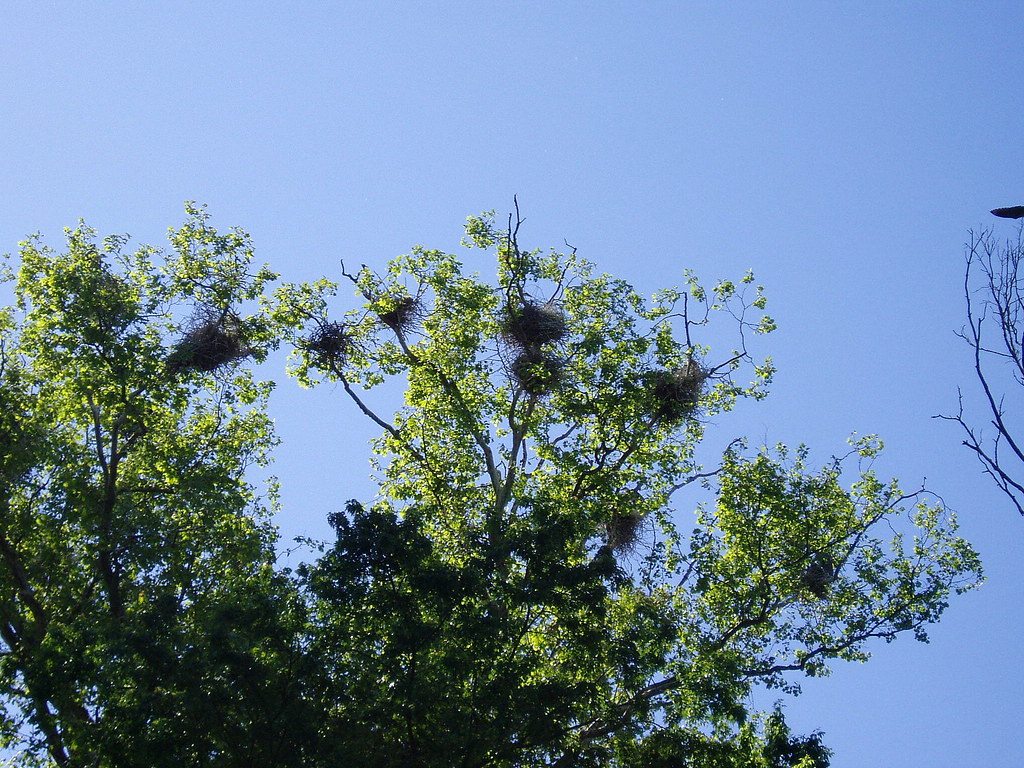 The Nighthawks, Ruby-Throated Hummingbirds and Chimney Swifts have all arrived on the scene and the seventeen-year cicadas are starting to emerge out on the east side of town, so as far as I'm concerned, summer has officially arrived.
The Nighthawks, Ruby-Throated Hummingbirds and Chimney Swifts have all arrived on the scene and the seventeen-year cicadas are starting to emerge out on the east side of town, so as far as I'm concerned, summer has officially arrived. One of the highlights of the long weekend was a fourteen mile kayak trip down the Little Miami. I arrived on the river at eight in the morning, well before the "cabrewers" showed up. There were simply scads of birds about, including Spotted Sandpipers, Cedar Waxwings, Waterthrush and Black Vultures. I floated past a Great Blue Heron rookery, in which I counted twenty nests, though I'm sure there were more that I couldn't see. In fact, I floated past it three times, since I kept paddling back upstream to take in the sight. I apologize for the poor picture quality, but I'm nervous about taking my good camera out on the river, so I had to settle for my cheap, water-resistant digital with a mere 4X zoom. There are some nice photos and descriptions of heron courtship, breeding and nesting behavior at the Great Blue Heron Rookery website.
Saturday, May 24, 2008
More on Furoshiki
Thursday, May 22, 2008
Color Me Intrigued...
How To Eat A Mangosteen
Now I just have to track them down. I imagine Jungle Jim's will carry them. I'm planning a trip there soon anyway - when I was getting my hair cut the other day, the owner of the salon was going on about how excited he was to have found dried squid in Cincinnati. He was disappointed he's not convinced anyone else to try it and I told him I loved squid and I wanted to try it myself. He went in back and brought out a pack of dried squid and I have to say it was delicious. It was slightly sweet, slightly salty with a nice seafood taste and the texture was more tender than that of beef jerky. He found it at Jungle Jim's in the Asian section, so I need to hunt some up myself. It would make a great snack to take along hiking or kayaking.
Wednesday, May 21, 2008
Columbine
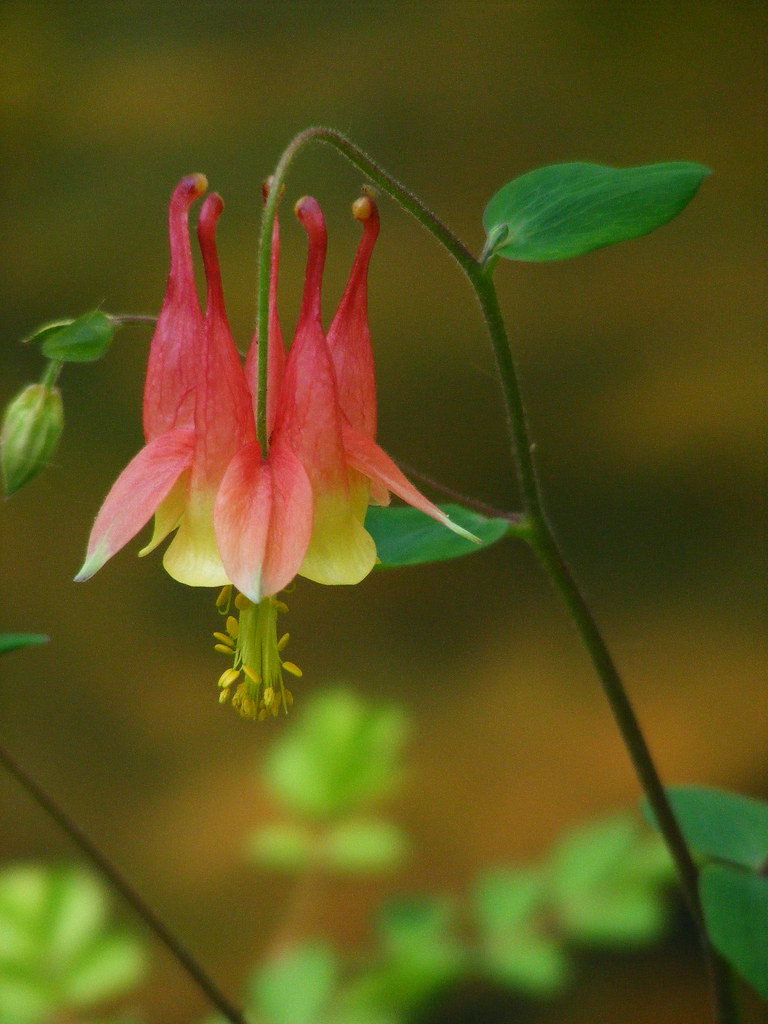 One of my favorite Ohio wildflowers blooms this time of year. The wild columbine prefers thin soils and can be found clinging to the sides of cliff faces and boulders in woodlands across Ohio. Their flowering coincides with the first arriving hummingbirds, which are well adapted to reach the nectar stored in the upper ends of the long spurs of the blossom.
One of my favorite Ohio wildflowers blooms this time of year. The wild columbine prefers thin soils and can be found clinging to the sides of cliff faces and boulders in woodlands across Ohio. Their flowering coincides with the first arriving hummingbirds, which are well adapted to reach the nectar stored in the upper ends of the long spurs of the blossom. The flower takes its name from columba, from the Latin word for dove. Some early aficionado thought the flower's unique shape resembled a group of doves perched around a fountain. The genus of the flower also takes its name from a bird; Aquilegia is Latin for "eagle-like" and refers to the resemblance of the flower to an eagle's talons.
In legend, the columbine is considered to be a symbol of foolishness, because the flower looks like the flounced hat of a court jester. It is considered to be bad luck to give a columbine to a woman for this reason. The wild columbine is also associated with a legend of the Virgin Mary. The fallen petals look like tiny slippers and it is said that columbine plants arose wherever Mary stepped on her way to visit her cousin Elizabeth, so sometimes columbine goes by the common name Our Lady's Shoes or the Virgin Mary's Shoes.
There are many domesticated cultivars of columbine, the flowers of most of which are upturned, but my favorite remains the lovely nodding flowers of the wild columbine. The fact that they grow in some of the prettiest spots in Ohio is probably no small factor in my preference.
Tuesday, May 20, 2008
On Shrews
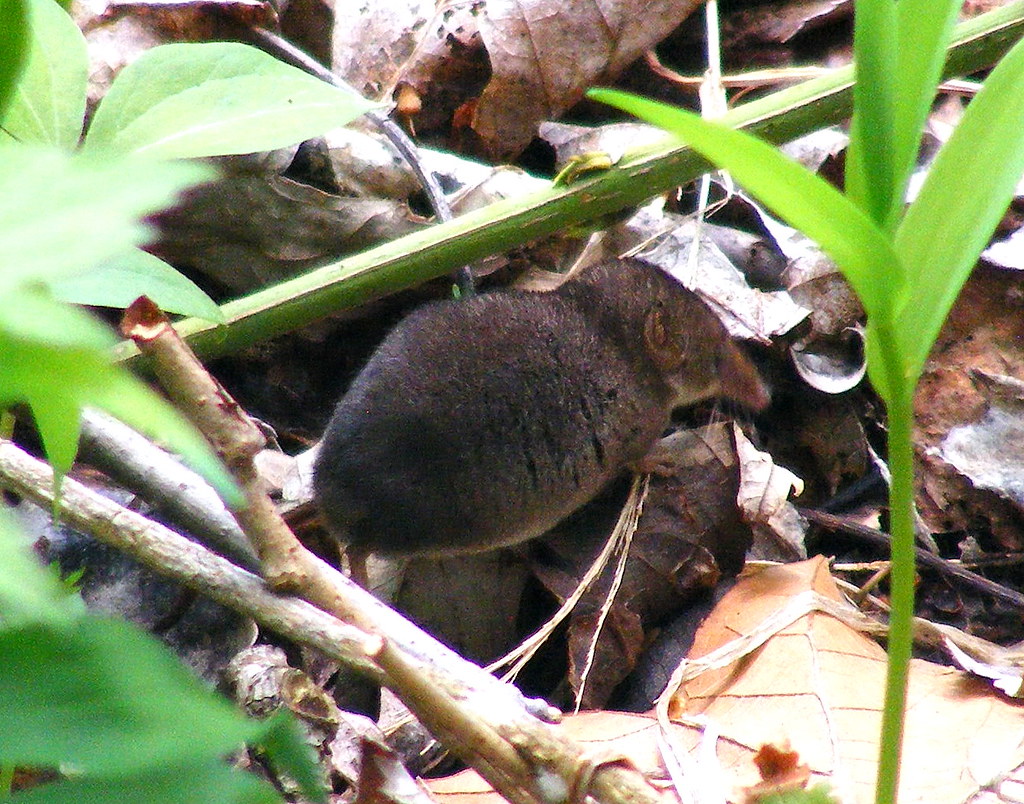 I was lucky enough to spot this shrew hunting in the leaf litter when I was at Cedar Bog a couple of weeks ago. Shrews have rather poor eyesight, so by moving slowly I was able to get down on my hands and knees on the boardwalk and follow its movements for nearly fifteen minutes. It took a good ten minutes just to get this shot, as it was in constant motion and usually obscured by leaves.
I was lucky enough to spot this shrew hunting in the leaf litter when I was at Cedar Bog a couple of weeks ago. Shrews have rather poor eyesight, so by moving slowly I was able to get down on my hands and knees on the boardwalk and follow its movements for nearly fifteen minutes. It took a good ten minutes just to get this shot, as it was in constant motion and usually obscured by leaves. Although they superficially resemble rodents, shrews are insectivores and close relatives of moles. They are voracious predators, possessed of an incredibly high metabolism - some species can starve to death in as little as seven hours. They are constantly on the hunt and their primary prey consists of various invertebrates, including earthworms, centipedes, spiders and insects of all varieties. Some species produce a toxic venom, making them one of the very few venomous mammals in the world.
Judging by its size (two inches long, not including the inch long tail) and the range map in my mammal field guide, I believe the pictured animal is a least shrew, but positive identification is tricky. My guide says the least shrew has thirty teeth, which is of course useless as a field mark. I was quite content to have the pleasure of watching it for a while without taking it apart to identify it.
Saturday, May 17, 2008
Thursday, May 15, 2008
Again with the bad blogger thing
- Shrews
- Bleu Cheese
- The butterfly exhibit at Krohn Conservatory
- Gypsy Moths
- How to make yogurt at home
- The perils of vanity sizing in women's clothing
Sunday, May 04, 2008
Cedar Bog
 The preserve is protected by the Ohio Historical Society and there is a nearly mile long boardwalk winding through the fen. The plant life is spectacular and there were loads of wildflowers in bloom today, including Jack-in-the-Pulpit, White Trillium, Bent Trillium, Bishop's Cap, Wild Columbine, Golden Ragwort and Starry False Solomon's Seal. I'm already planning another trip in about four weeks when the Showy Lady's Slipper, one of our native orchids, will be in bloom.
The preserve is protected by the Ohio Historical Society and there is a nearly mile long boardwalk winding through the fen. The plant life is spectacular and there were loads of wildflowers in bloom today, including Jack-in-the-Pulpit, White Trillium, Bent Trillium, Bishop's Cap, Wild Columbine, Golden Ragwort and Starry False Solomon's Seal. I'm already planning another trip in about four weeks when the Showy Lady's Slipper, one of our native orchids, will be in bloom.
Thursday, May 01, 2008
Sunflowers on May Day
Historically May Day has commemorated the coming of spring and a recognition of workers' rights. Here's another cause for its celebration: International Sunflower Guerrilla Day. It's easy, it's fun, it's slightly subversive and it brings joy to all who look upon its fruits. What could be bad?
Here's how to do it: Find a crummy, neglected and sunny public space somewhere near your place. Get some sunflower seeds, the bigger the flower, the better. Take a bottle of water and a little spade, stick or soup spoon with you to the spot. Dig a hole about 3/4 of an inch deep. Drop in a seed and water it. Return every once in a while to water it and clean off the litter. Watch the little seedling grow into full bloom by August. If you want to show your success to the world; take a picture and post it on the community website. Fellow gardeners in Brussels, London and France will be doing it too. Happy May Day, however you choose to celebrate it.
For the less subversive, one might choose to participate in the Great Sunflower Project, a citizen science activity in which people plant sunflowers in their garden and report visits by bees. Here's how participation in the project will help:
Your home, school or community garden and those around the world produce roughly 15-20% of all the food we eat. And for the urban poor, who spend 50-70% of their income on food, these gardens are a real source of good nutrition and an essential route to food security.
Whether your garden contains vegetables, fruit trees, flowers, or even medicinal plants, many of these plants must be pollinated before a fruit forms. And as the headlines for the last year have made clear, bees are under threat. Here is a link to information about some of our bees in peril.
We know very little about bee activity in home and community gardens and their surrounding environments, but we are certain that they are a crucial link in the survival of native habitats and local produce, not to mention our beautiful urban gardens. Our local pollinator populations require our understanding & protection, and to answer that call we need to determine where and when they are at work.
With enough citizen scientists collecting data, we can learn much more, much faster, about the current state of bee activity. We would love to have you join us; let’s learn about pollinators together!
Tuesday, April 29, 2008
Composting
Sunday, April 27, 2008
Weekend Report
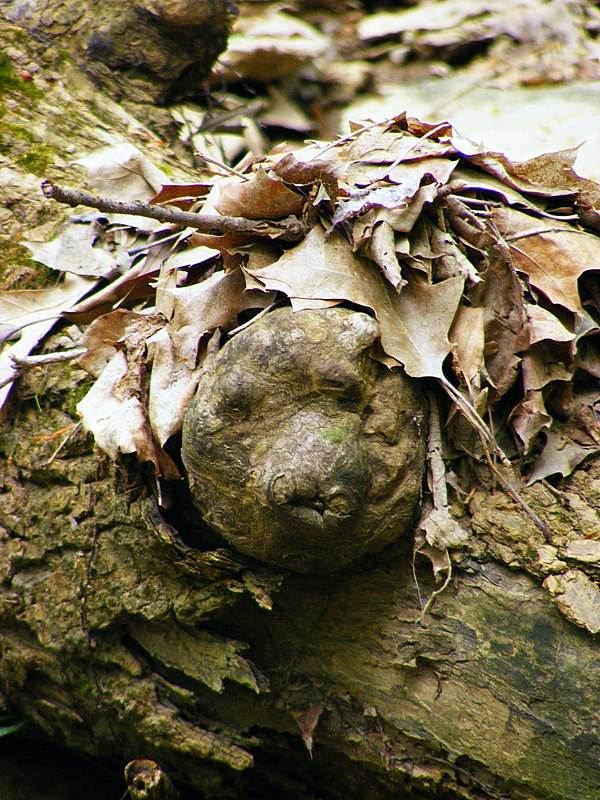 Saturday morning I got up bright and early and dashed down to Findlay Market to see what goodies were available. I found (and brought home) asparagus, spinach, sorrel, eggs and a pot of thyme, all locally grown. I also found fresh fava beans at Madison's so I grabbed some of those as well. I'm going to make sorrel soup from the recipe I found on the Cincinnati Locavore blog tomorrow night.
Saturday morning I got up bright and early and dashed down to Findlay Market to see what goodies were available. I found (and brought home) asparagus, spinach, sorrel, eggs and a pot of thyme, all locally grown. I also found fresh fava beans at Madison's so I grabbed some of those as well. I'm going to make sorrel soup from the recipe I found on the Cincinnati Locavore blog tomorrow night.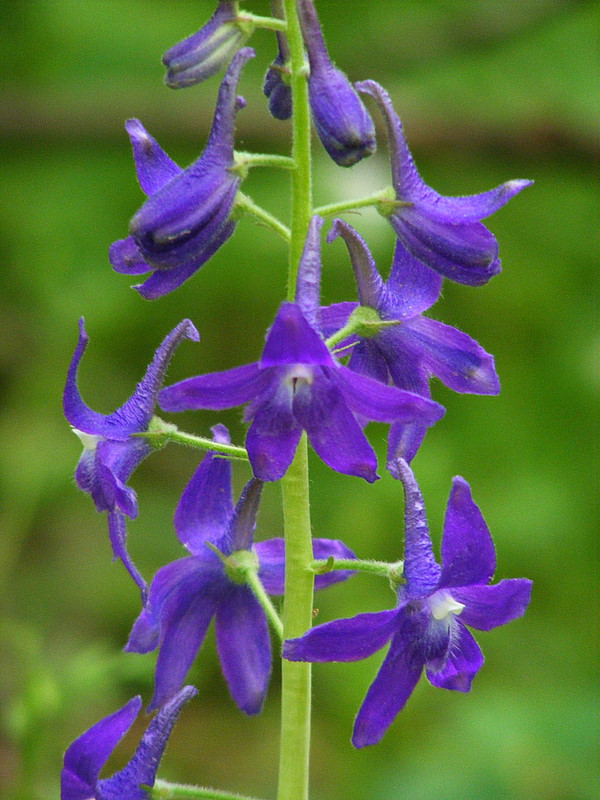
I'd planned to spend the rest of the weekend at home finishing my spring cleaning, but today was just too nice outside and I dropped everything this afternoon to get in a quick two and a half mile hike over at French Park. I'm glad I did; I heard reedy calls of Gnatcatchers several times and I also heard the first Red-Eyed Vireo and Hermit Thrush of the season. Larkspur and Blue-Eyed Mary were in bloom as well. Unfortunately, French Park seems to be a bit sparse on native wildflowers and heavy in the introduced and problematic Garlic Mustard; there was scads of it blooming on the hillsides. I guess deer don't care much for its flavor.
Saturday, April 26, 2008
Walking
But barefoot is hardly a choice for me, even when not working. Despite the fact that I walk an awful lot for pleasure, my bare soles are tender and I couldn't walk across more than a few feet of pavement without wincing and mincing, not to mention the dangers of encountering glass or dog poop. The article did suggest some footwear that is designed to allow the barefoot gait while offering some protection against our urban environments, but they tended to be ironically expensive for things trying to be so very natural.
That leaves me considering investing in moccasins. Proper ones, made of real, durable leather, not the little slippers designed only for indoor use. The New York Magazine article only mentioned moccasins in passing, but they're really the time-tested footwear for walking as close to barefoot as possible while adding protection for the foot. I found a place in Minnesota that will custom make moccasins using the outline of your foot as a template. Before I try that though I'm going to look around locally a little more and see if there isn't a moccasin-maker a bit closer to me so I could try them on first.
In the mean time, I am going to go and have a look at Vibram Five-Fingers for kayaking purposes. They look a bit silly, but also fun.
Friday, April 25, 2008
European Wall Lizards
The article initially caught my eye because Cincinnati has been home to an introduced population of European Wall Lizards since 1951, when a handful of lizards were released by a member of the Lazarus family, they of department store fame. In fact, the lizards are sometimes known locally as "Lazarus Lizards". I've encountered them often around town; they especially seem to love Mount Adams and other areas with lots of stone walls.
Tuesday, April 22, 2008
Ramp Report
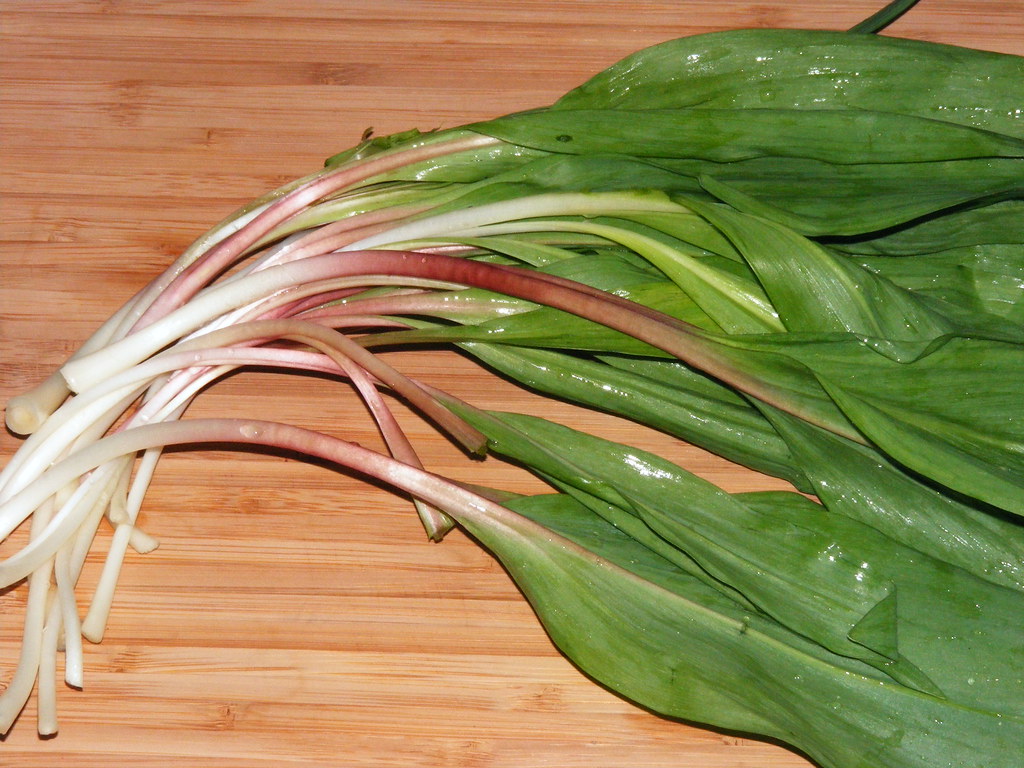 I cooked the ramps I purchased at Madison's at Findlay Market for Sunday breakfast. I cleaned the ramps by snipping off the roots, rinsing them well in cold water and cutting them into two-inch sections, green leaves and all. I sautéed a couple of pieces of bacon until they were nice and crisp, then set them aside. Then I cooked the ramps in the bacon fat until they were tender, which took about seven minutes. I seasoned them with black pepper and crumbled the bacon into them, then served alongside scrambled eggs. The taste was somewhat like that of a garlicky green onion. They were delicious, but probably not eighteen dollars a pound delicious. I don't think I'll be buying them again unless it's at a proper ramp festival in the mountains, but I'd happily forage for them if I'm ever lucky enough to find them growing in the woods.
I cooked the ramps I purchased at Madison's at Findlay Market for Sunday breakfast. I cleaned the ramps by snipping off the roots, rinsing them well in cold water and cutting them into two-inch sections, green leaves and all. I sautéed a couple of pieces of bacon until they were nice and crisp, then set them aside. Then I cooked the ramps in the bacon fat until they were tender, which took about seven minutes. I seasoned them with black pepper and crumbled the bacon into them, then served alongside scrambled eggs. The taste was somewhat like that of a garlicky green onion. They were delicious, but probably not eighteen dollars a pound delicious. I don't think I'll be buying them again unless it's at a proper ramp festival in the mountains, but I'd happily forage for them if I'm ever lucky enough to find them growing in the woods.
Monday, April 21, 2008
Waste less food, save more energy
The whiteboards were a heck of a lot cheaper than buying a glass-doored refrigerator.
Saturday, April 19, 2008
Around town
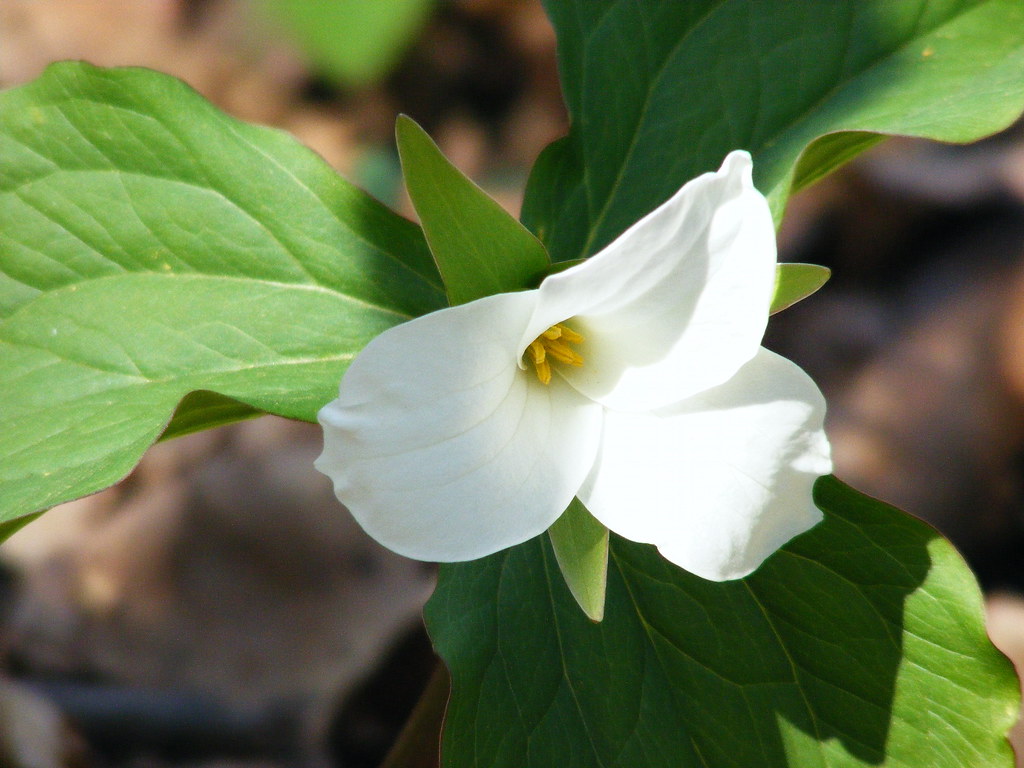 I found trillium blooming for the first time this spring during my quick walk around the Caldwell Nature Preserve yesterday after work. Digital cameras are terrible at photographing white objects; the nuances tend to get lost. Trying to photograph a white flower is difficult for this reason and I was crawling (carefully, so as not to smush other wildflowers) all over the hillside trying to find a trillium in just the right amount of shade. I think I'll start carrying a sheet of paper with me for creating my own dappled sunlight in the future.
I found trillium blooming for the first time this spring during my quick walk around the Caldwell Nature Preserve yesterday after work. Digital cameras are terrible at photographing white objects; the nuances tend to get lost. Trying to photograph a white flower is difficult for this reason and I was crawling (carefully, so as not to smush other wildflowers) all over the hillside trying to find a trillium in just the right amount of shade. I think I'll start carrying a sheet of paper with me for creating my own dappled sunlight in the future.Early this morning I went down to Findlay Market and blew my grocery budget for the week. I brought home a few things I've not cooked with before, including rhubarb, ramps ($18 a pound!) and the spice Grains of Paradise. The afternoon was spent in the company of friends down at the Earth Day celebration at Sawyer Point. Somehow the rain held off and we managed to score a few good freebies, including CFL light bulbs. Here's a tiny handful of useful links I picked up today:
- Get a bin, find out what items can be recyled and find information on hazardous household waste drop-offs - Hamilton County Department of Environmental Services
- Soil fertility testing kits are available for a nominal fee from the Hamilton County Soil & Water Conservation District
- The Ohio River Sweep will be held this year on Saturday, June 21st
- Enright Ridge is an Urban Eco-Village is a community fostering a sustainable urban neighborhood, located on the west side of Cincinnati
- Although I didn't see them at the Sawyer Point Earth Day celebration I'm posting a link to Little Miami, Inc. - dedicated to preserving my favorite local river
Friday, April 18, 2008
Earthquake in Cincinnati!
 I was just awakened (about 5:40 AM) by the windows of my bedroom rattling and my bed rocking back and forth. The shaking lasted about ten seconds. The morning news is reporting other people feeling earth tremors in the area. I've never felt an earthquake before!
I was just awakened (about 5:40 AM) by the windows of my bedroom rattling and my bed rocking back and forth. The shaking lasted about ten seconds. The morning news is reporting other people feeling earth tremors in the area. I've never felt an earthquake before!According to the USGS it was a 5.4 degree quake centered in southern Illinois.
From WCPO: 5.4 Earthquake Rocks Illinois, Rattles Tri-State. We even made the world news; here's a report from the BBC.
Thursday, April 17, 2008
Juniper Berries
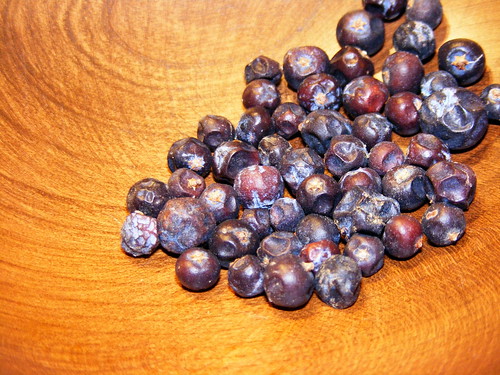 I decided to cook the lamb shanks I've had in the freezer for a while now and I found a nice recipe for Greek lamb braised in red wine. The recipe called for juniper berries and I did manage to find some - at more than five dollars for a little jar! I purchased them anyway so I'll have to find some other uses for them. According to Chowhound.com they have an affinity for the following foods: allspice, apple, bacon, black pepper, boar, duck, goose, marjoram, onion, pâté, pork, sage, shallot, red wine, thyme, venison, vermouth.
I decided to cook the lamb shanks I've had in the freezer for a while now and I found a nice recipe for Greek lamb braised in red wine. The recipe called for juniper berries and I did manage to find some - at more than five dollars for a little jar! I purchased them anyway so I'll have to find some other uses for them. According to Chowhound.com they have an affinity for the following foods: allspice, apple, bacon, black pepper, boar, duck, goose, marjoram, onion, pâté, pork, sage, shallot, red wine, thyme, venison, vermouth.The juniper is an evergreen tree native to Europe and North America and it produces small bluish berries (actually a tiny, densely packed cone) which take three years to mature. Juniper berries have been used since the times of the ancient Romans, Greeks and Egyptians. Pliny mentioned that they were used in place of expensive imported black pepper and juniper berries were found in the tomb of Tutankhamun.
Juniper berries are probably best known today for giving the liquor gin its characteristic flavor. The word "gin" is a corruption of genièvre, the French word for juniper.
Celtic lore tells us the juniper grown by the door will discourage thieves (probably because it's a prickly plant), while hanging strings of dried juniper berries will attract love.
Wednesday, April 16, 2008
The Return of the Cicada
 WCPO reported today that Cincinnati is due to see a return of the periodic cicada this summer. I was in town for the 1991 and the 2004 emergence and those were spectacular. This year's brood is more to the east of the city than those previous emergences so I'll probably have to take a drive to see it in all its glory.
WCPO reported today that Cincinnati is due to see a return of the periodic cicada this summer. I was in town for the 1991 and the 2004 emergence and those were spectacular. This year's brood is more to the east of the city than those previous emergences so I'll probably have to take a drive to see it in all its glory.Photo by tlindenbaum by way of Flickr.
Tuesday, April 15, 2008
Labyrinthitis
Monday, April 14, 2008
Earth Day in Cincinnati, 2008
 Earth Day is Tuesday April 22nd. Here are some links to events and celebrations in the Cincinnati area.
Earth Day is Tuesday April 22nd. Here are some links to events and celebrations in the Cincinnati area.Earth Day at Sawyer Point is the big event held April 19th from noon until 7 PM. There will be music, contests, an awards ceremony and much more.
Glenwood Gardens Highfield Discovery Garden has programs this week to celebrate Earth Day. Learn how to beautify your world by planting flowers, learn how to reduce your impact on the earth by reducing, reusing and recycling everyday products. Programs are Tuesday (April 22nd) through Saturday (April 26th) at 10:45 am, 1 pm and 4 pm; Sunday (April 27th) at 1 pm and 4 pm.
Blue Ash Nature Park (4433 Cooper Road, Blue Ash, OH 45242 513-745-8550) is hosting an Earth Day event on Friday, April 25, 2008 from 4 PM to 7 PM. This special event will include Toyota, Rumpke, Veg Head, Gorman Heritage Farm, demonstrations, free samples, family activities and more.
This Land is Your Land Earth Day Celebration Thursday, April 18 11:00 AM - 1:00 PM Fountain Square
To celebrate Earth Day 2008, Cincinnati Computer Cooperative (C3) will participate in the Recycling Collection event being held on Saturday April 19 at the Miami Township Service Department, 5900 McPicken Drive, in Clermont County from 9:00 AM to 12:00 PM, and an E-Cycling event on Saturday April 26 from 9:00 AM to 12:00 PM at its facility, 49 Novner Drive, Cincinnati, Ohio (Woodlawn) Phone 513-771-3262.
More links to events world-wide can be found at Earthday Network.
Sunday, April 13, 2008
Late to the party
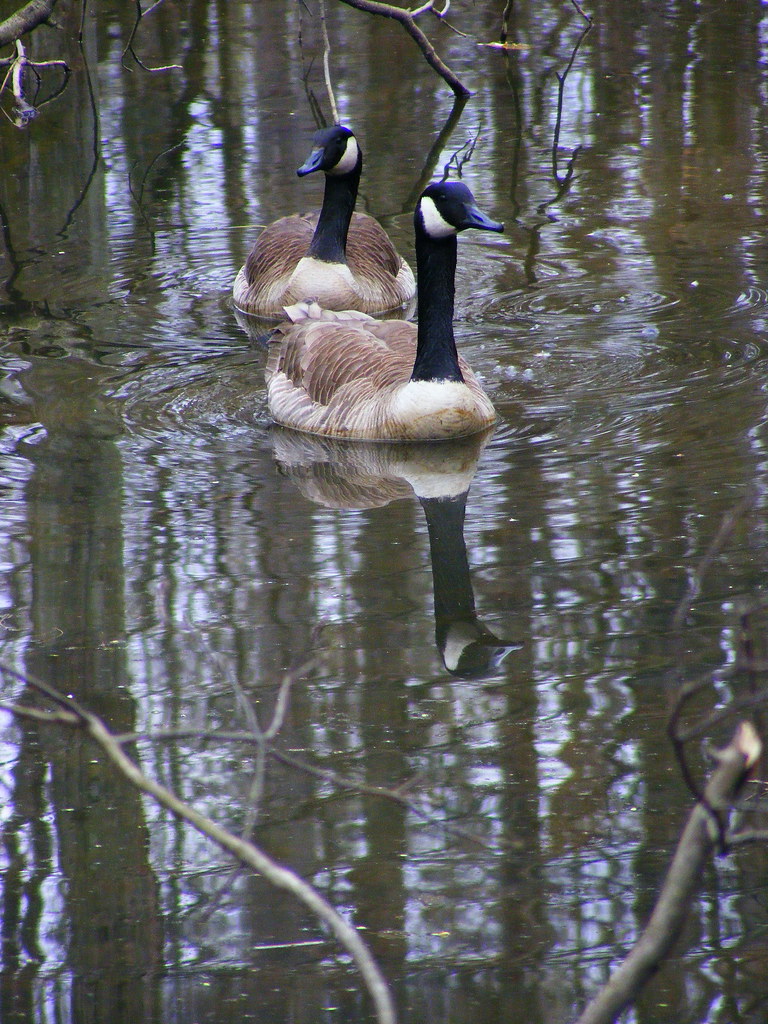 Well, I missed out on the fact that the American Ornithologist's Union had split the Canada Goose subspecies into two distinct species back in 2004. I knew the Canada Goose (pictured) had several subspecies before, mostly varying in size (smaller to the north) and coloration (darker to the west). Results from genetic analysis revealed that four of the smallest subspecies of the Canada Goose were quite distinct from the larger subspecies and the A.O.U. decided they were sufficiently different to be known as a separate species called the Cackling Goose.
Well, I missed out on the fact that the American Ornithologist's Union had split the Canada Goose subspecies into two distinct species back in 2004. I knew the Canada Goose (pictured) had several subspecies before, mostly varying in size (smaller to the north) and coloration (darker to the west). Results from genetic analysis revealed that four of the smallest subspecies of the Canada Goose were quite distinct from the larger subspecies and the A.O.U. decided they were sufficiently different to be known as a separate species called the Cackling Goose.The conundrum this poses for birders is well illustrated in the article The New Goose. I've no idea if I've seen this bird or not; I certainly saw tiny Canada Geese during visits to California in the past but I didn't give them much thought. On my next visit I'll be paying more attention.
Saturday, April 12, 2008
Bloodroot
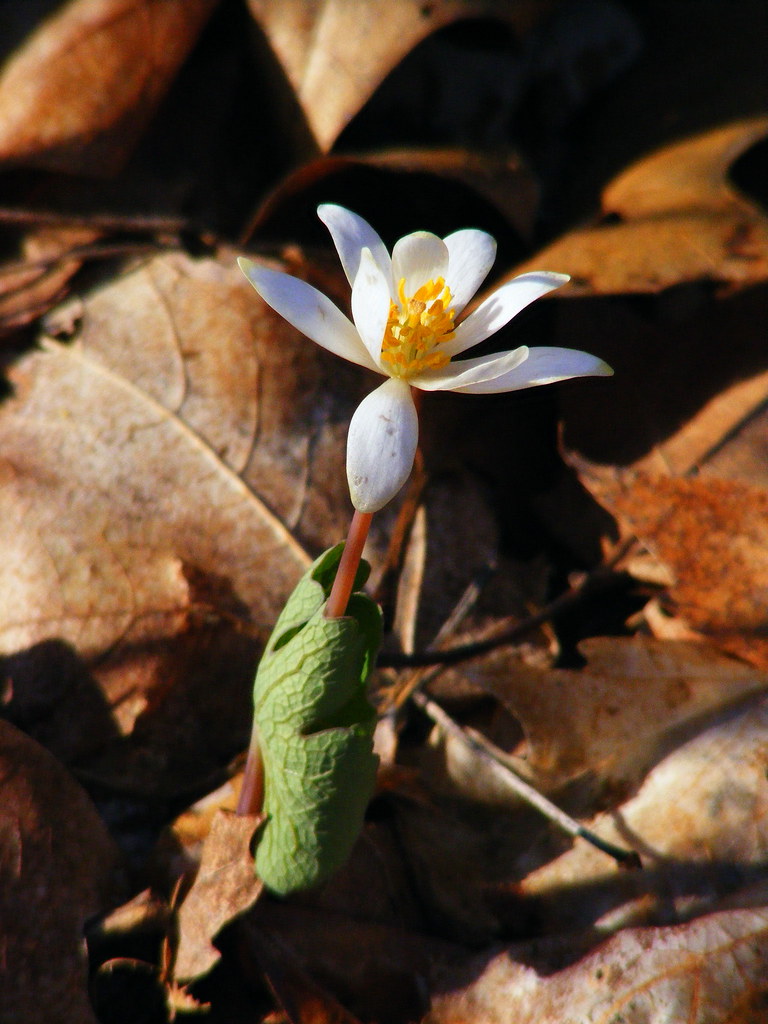 Bloodroot (Sanguinaria canadensis) is blooming in our area now, but I've been thwarted in my efforts to get a decent photo this year. I have one good picture of the blossom and another of the leaf, but not both at the same time.
Bloodroot (Sanguinaria canadensis) is blooming in our area now, but I've been thwarted in my efforts to get a decent photo this year. I have one good picture of the blossom and another of the leaf, but not both at the same time.Bloodroot is so named because when the root is damaged it emits a blood red juice. This liquid was used by Native Americans as a dye for baskets and clothing and for painting their faces and bodies.
 Although, or perhaps because, the plant has toxic properties it has long been used as a medication. Bloodroot is known to contain an escharotic, a substance that kills tissue, and the juice has been used in preparations to kill ringworm, fungal growths and warts. It is also used in mouthwashes to kill gingivitis and plaque. Despite its useful properties, self-medication is an exceedingly bad idea due to the plant's poisonous substances. It's far too lovely a plant to destroy in any case.
Although, or perhaps because, the plant has toxic properties it has long been used as a medication. Bloodroot is known to contain an escharotic, a substance that kills tissue, and the juice has been used in preparations to kill ringworm, fungal growths and warts. It is also used in mouthwashes to kill gingivitis and plaque. Despite its useful properties, self-medication is an exceedingly bad idea due to the plant's poisonous substances. It's far too lovely a plant to destroy in any case.
Thursday, April 10, 2008
The Evil Virus, how to construct a lodge and making homemade cheese
 I was flipping through the channels tonight when I came across a naturalist talking about how beaver lodges are constructed. I had always assumed that during construction the beavers left a hollow space within the pile of branches and mud that comprises the building material of the lodge. As it turns out they first build the dense mound of material, then working from below, use their claws and teeth to dig and chew the underwater entrance and the burrow.
I was flipping through the channels tonight when I came across a naturalist talking about how beaver lodges are constructed. I had always assumed that during construction the beavers left a hollow space within the pile of branches and mud that comprises the building material of the lodge. As it turns out they first build the dense mound of material, then working from below, use their claws and teeth to dig and chew the underwater entrance and the burrow.I also came across instructions on how to make mozzarella cheese at home, which I may try once I'm healthy again. It looks like a good choice for a home cheese making experiment since it doesn't have to be aged. Although perhaps starting with something simpler might not be a bad plan - home made cottage cheese is supposed to be very good.
Wednesday, April 09, 2008
Seahorses in London
 Little seahorses have been found in the Thames river in England as far upstream as London, according to this article in National Geographic. The Thames is an ecological recovery success story. Subjected to decades of pollution, the Thames was declared biologically dead in the 1950s. Serious efforts to clean up the river began about twenty years ago and have had marvelous results. The river is the cleanest it's been since pre-industrial times and a number of extirpated species are reclaiming their old stomping grounds. In addition to the seahorses, brown trout, Atlantic salmon, dolphins, seals and one lost whale have been spotted in the Thames in recent years.
Little seahorses have been found in the Thames river in England as far upstream as London, according to this article in National Geographic. The Thames is an ecological recovery success story. Subjected to decades of pollution, the Thames was declared biologically dead in the 1950s. Serious efforts to clean up the river began about twenty years ago and have had marvelous results. The river is the cleanest it's been since pre-industrial times and a number of extirpated species are reclaiming their old stomping grounds. In addition to the seahorses, brown trout, Atlantic salmon, dolphins, seals and one lost whale have been spotted in the Thames in recent years.
Monday, April 07, 2008
Mondays...
I did walk the long path around Glenwood Gardens after work today and spotted about a half dozen Blue Winged Teal in one of the small ponds on their grounds. I'm always happy to see those pretty little ducks.
I leave you with a video on how to make a brimmed beanie out of an old sweater.
Sunday, April 06, 2008
Go Local, Go Organic
Did Your Shopping List Kill a Songbird?
Spring Ephemerals
The morning started off chilly but quickly warmed as the sun rose higher into the sky. I happened to be hiking along a stream bed surrounded by a meadow when the temperature passed a certain threshold and suddenly the air was filled with the calls of Spring Peepers. That is the sort of thing that makes getting up before dark on a Sunday morning and heading out into the woods completely worthwhile.
Saturday, April 05, 2008
Posole and Hominy
 My mind has been on Mexican and Tex-Mex food since I returned from San Antonio. I came across a can of white hominy in the cupboard and so decided to try my hand at making posole for the first time. Posole is a stew, generally made from pork, hominy and chilies, served all across Mexico and the American Southwest. The first thing I discovered while searching for a recipe is that there are thousands of them. I chose a simple, reputably authentic recipe from Urban Farm Girl mostly because there were few ingredients and I had all of them on hand. I used an ancho chile along with the red chilies and I had to substitute dried, granulated garlic for fresh (I am unaccountably out of garlic and didn't want to run to the store for just that); otherwise I followed the recipe and it was delicious. I made it in my seldom-used cast iron dutch oven; I'm thinking this would be a good dish to make over a campfire.
My mind has been on Mexican and Tex-Mex food since I returned from San Antonio. I came across a can of white hominy in the cupboard and so decided to try my hand at making posole for the first time. Posole is a stew, generally made from pork, hominy and chilies, served all across Mexico and the American Southwest. The first thing I discovered while searching for a recipe is that there are thousands of them. I chose a simple, reputably authentic recipe from Urban Farm Girl mostly because there were few ingredients and I had all of them on hand. I used an ancho chile along with the red chilies and I had to substitute dried, granulated garlic for fresh (I am unaccountably out of garlic and didn't want to run to the store for just that); otherwise I followed the recipe and it was delicious. I made it in my seldom-used cast iron dutch oven; I'm thinking this would be a good dish to make over a campfire.Not only was it the first time I tried posole, but it was the first time I ever had hominy either. What can I say, I haven't spent much time in the American South. I really liked it and I'm sorry I missed out on it all these years. The texture surprised me somewhat. It kept its integrity throughout a rather lengthy cooking process - almost more like a bean; fresh sweet corn wouldn't have held up nearly so well after cooking for two hours in a dutch oven.
Hominy is dried maize which has been treated with an alkali to remove its tough outer hull, through a process known as nixtamalization. Nixtamalization has been practiced since at least 1200 BC, the earliest archaeological evidence having been found in Guatemala. The process is crucial to not only removing the tough outer hull, but to unlocking the nutrients within the large, starchy grain. Alton Brown's episode of Good Eats - Tort(illa) Reform talked about this process in some detail and a portion of the transcript follows:
Transcript courtesy of Good Eats Fan Page
Once upon a time in 1519, a certain Spanish businessman/adventurer named Hernando Cortez landed in what is today Veracruz, Mexico. Why? Because he had a serious hankering for gold, which he soon found heaps of in the Aztec city-state of Tenochtitlán, which was, at the time, probably the most splendid city on earth.
Figuring he would be a far better steward of all that wealth, Cortez aided by cannons, horses, smallpox, and a legend that made him out to be a returning god, captured the city's ruler, Montezuma, and set about decimating one of the greatest civilizations our planet has ever hosted. Had Cortez stopped just for a moment to consider how it was that such heathen savages were able to erect such a bling-encrusted metropolis, he might have discovered a very different kind of gold altogether ...
SCENE 4
The Kitchen
GUEST: Deb Duchon, Nutritional Anthropologist
AB: ... maize. You know, the average Meso-American diet was very corny indeed. But unlike the sweet field corn we modern North American Anglos know and love, the stuff the Aztec lived on was very very starchy and came with a very thick outer hull, or pericarp, okay? Now, probably 10,000 years or so before Columbus showed up, these early Americans learned that if they...
DD: ... if they soaked and cooked the maize in water with wood ashes in it, that the hulls would just slip right off.
AB: You notice how I don't even have to think "nutritional anthropologist" anymore, and she shows up?
AB: Okay, I'll bite. What's with the wood ashes?
DD: They're alkaline, of course.
AB: Ah. Well, that certainly explains why, last summer, when I left all those ashes in my grill, and it rained a bunch, the bottom of the grill corroded out.
DD: I remember that. But today's Mexican cooks don't use wood ashes anymore. They use cal.
AB: Oh, short for calcium hydroxide, a.k.a. slaked lime. It's used in the construction business to help concrete harden.
DD: But the really fascinating thing about it was that the Meso-Americans thought they were just removing the pericarp, but what they were actually doing was setting in motion this miraculous and amazing phenomenon.
AB: I sure hope you're not about to launch into one of your long soliloquies without the benefit of a visual aid.
DD: Well, check this out then.
AB: Okay.
DD: The miracle of nixtamal... [DD clicks a remote and a large cage descends]
AB: Whoa. Wow, what a sweet visual metaphor representing the many nutrients locked away inside a kernel of corn. Hah, think I'll have a little proline. Hey, what gives? I can't get any of them out.
DD: Nixtamalization is like a chemical key that unlocks all the wonderful nutrients that are locked inside a kernel of maize.
AB: So what kind of nutrients are we talking about here?
DD: Well, for one thing, amino acids like lysine and tryptophan. But most importantly, vitamin B3 better known as niacin. Now if the Aztecs hadn't had nixtamalization, they wouldn't even have the energy to build that magnificent empire of theirs. And once Cortez showed up, he probably wouldn't even have paid much attention to them. He certainly had no reason to destroy their empire like he did.
AB: Got it.
DD: But in a way, they got their revenge, because when Cortez and the other conquistadores brought maize back to the Old World, they didn't take nixtamalization.
AB: Yeah.
DD: So the countries and peoples that adopted corn as their main grain soon suffered from a terrible disease of malnutrition called pellagra.
AB: What's pellagra do?
DD: The three dreaded Ds: diarrhea, dementia, and death.
AB: Well, I guess that's Montezuma's real revenge.
Friday, April 04, 2008
Mike Fink
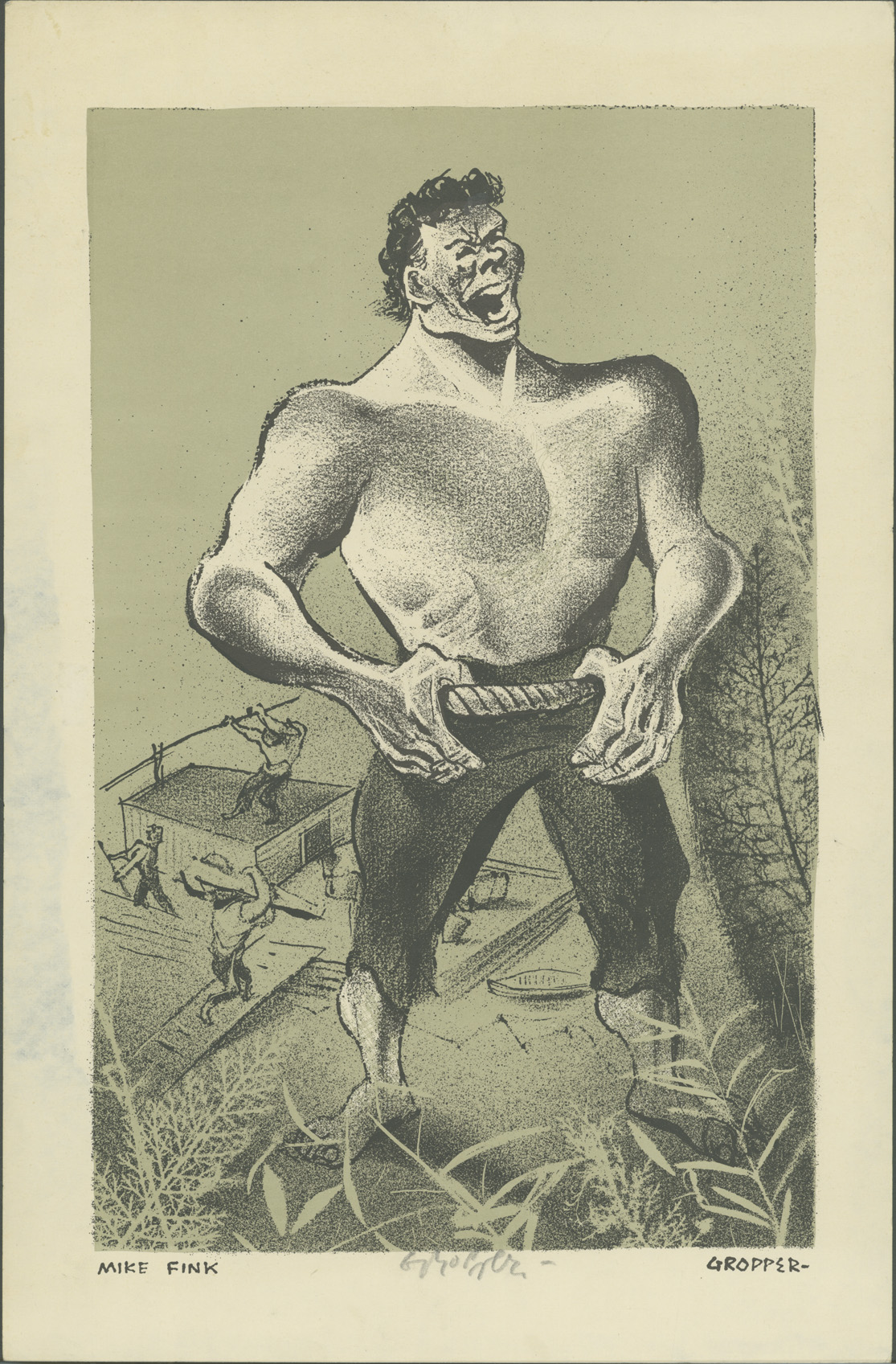 I'm not sure how I managed to live in a river city for forty some years without hearing or reading stories about Mike Fink. I knew of the riverboat by that name of course; I've even had a couple of meals there. But I never gave a second thought as to who Mike Fink was until I came across the name in a history of the Alamo yesterday.
I'm not sure how I managed to live in a river city for forty some years without hearing or reading stories about Mike Fink. I knew of the riverboat by that name of course; I've even had a couple of meals there. But I never gave a second thought as to who Mike Fink was until I came across the name in a history of the Alamo yesterday.Mike Fink was the known as "The Last of the Boatmen", one of those men who made their living navigating the large rivers of the American interior before the days of steam powered paddle-wheelers. He was a semi-legendary figure, born in the late 1700s in Pittsburgh, Pennsylvania to French-Canadian parents. The reason his name appeared in the Alamo history I read was because he was supposed to have crossed paths with Davey Crockett, who described Fink as "half horse and half alligator." All accounts describe his being a keen shot with a rifle, hard-drinking, popular with the ladies and possessing both a quick wit and a bad temper. For further edification, click the link below.
Thursday, April 03, 2008
Grocery Project
 I completed the first half of my grocery project on Monday. I photographed all the groceries I purchased during the month of March. I'm also going to photograph the groceries I buy in July, because that's when the farmer's market will be in full swing.
I completed the first half of my grocery project on Monday. I photographed all the groceries I purchased during the month of March. I'm also going to photograph the groceries I buy in July, because that's when the farmer's market will be in full swing.March is a little skewed because I was on vacation for almost a week and every meal while away was eaten in a restaurant. I didn't bother to include those meals in my total since when I'm not on vacation I only eat out once or twice a month at best. I spent a total of $230 on groceries for the month and I think that's somewhat under my average monthly bill, which I figure to be around $300.
This project was inspired by looking at these photos and I simply was curious to see how my purchases compared. I think my spending is on par with the average American's spending. I'm not a terribly frugal shopper when it comes to groceries though. I tend to buy what I want without worrying about price, I try to buy quality stuff and I don't use coupons. This is probably balanced out by not buying many "convenience" foods, which are often more expensive and less nutritious than whole foods.
So if you find yourself terribly bored, you can have a gander at what my groceries look like for one month. If you've done a similar project, I'd love to see it too!
Wednesday, April 02, 2008
Restaurants, San Antonio
 This is my last post about San Antonio, honest. Mostly I wanted to note the better restaurants I went to for future reference; I am planning a return trip.
This is my last post about San Antonio, honest. Mostly I wanted to note the better restaurants I went to for future reference; I am planning a return trip.Most of the food on the Riverwalk is mediocre at best, but happily there is one exception - Acenar. The guacamole made tableside by Ricardo was fabulous. For my entrée I had the Gulf Fish Tacos and my sister had Conchita Pibil and I thought they were both wonderful.
The Blanco Cafe at 419 N. St. Mary's Street was voted the best breakfast tacos in town by the locals. I think the most expensive taco on the menu was $1.89 and one taco was enough to keep me going until lunch. I had the potato and chorizo one morning and egg and beans the next. They were both great; I've been craving them ever since.
I had dinner on my own at Azuca, where I tried a Caipirinha (the national drink of Brazil) for the first time. The sugar and lime didn't disguise the fact the the cachaça, a sugarcane liquor, has some serious claws. I opted for a "light" dinner of a cup of black bean soup and the appetizer of Amazonian Tamal; both were delicious and I couldn't finish everything. I was served a mini-loaf of hot cornbread along side my meal which ended up being my breakfast the next day.
I already mentioned Harmon's Barbecue in my previous post, but I neglected to say that it was the only place I've ever been that has self-serve beer. Seriously. You pay for your beer at the counter and there is an ice bin in the middle of the floor filled with bottles of beer and you help yourself. Amazing.
For lunch one day I ordered a salad at a nameless Riverwalk restaurant just because it came with nopalitas, or cactus paddles. I'd never tried them before and I was curious. I remain curious, because they came pickled and really only tasted like a mushy pickled vegetable. They do show up fresh in the markets around here from time to time; I'll bring some home next time I see them and figure out how to cook them.


